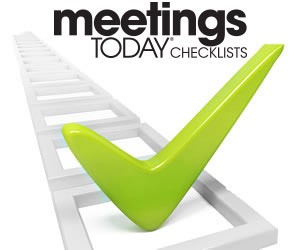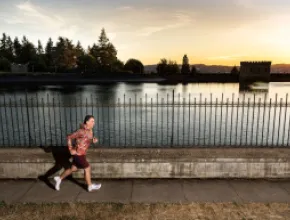Things to document regarding the venue
- Verify the room capacity charts.
Note exact room dimensions, not just room capacities - Ceiling heights are VERY important to document.
Note changes in height, soffits and verify the height of each. - Power is more than having a few wall plugs available.
Note the location and capacity of all room power.
Note the location of all room lighting controls. - Note the locations and size of the loading dock.
Also note dock height or if a lift gate would be needed. - Listen to the house sound system
Most are suitable for basic meetings, but may not have good fidelity or
control.
Things to consider and note in the room
- Ceiling
- Walls
- Floors
- Columns
- Windows
- Lighting
- Mirrors
- Doors
- Electrical power
- Exits
Things to avoid
- Low hanging chandeliers
Those can require smaller and/or more screens for audience - Windows that don’t darken or are uncovered
- Low ceiling heights
- Columns
- Mirrors
- Non Dimming Lighting
- Lack of set up time
Suggested general rules for room capacity, screen size and distances
- A general rule of thumb is to divide the facility square footage of the room by 10’ per person for theatre capacity and by 15’ per person for classroom capacity.
- 5’ principle states that the minimum distance from the bottom of a screen to the floor is 5’.
- 2x8 principle states that no one should be seated closer to the screen than two times the height of the image, nor further than eight times the height of the image.
Common questions to ask a potential vendor
- How much equipment is kept on property?
- Can you provide a detailed quote with specific equipment listed?
- How large is the staff at the venue?
- Will a technician be assigned to my group?
- How long will it take to set up the gear?
- Do you have a local warehouse?
- (For larger events) Can you provide me with a CAD drawing of the room?
- Is security available?
- Can the room be secured?
- Are their additional charges for power or service?
Vendor questions for the planner
- What are you trying to communicate at this event?
- What is the purpose of the meeting? (Sales, Education, Motivation, Fun?)
- What is the audience size and seating arrangement?
- Who makes up your audience?
- What AV support has been requested by your presenter?
- Will you be using Power Point?
- Will you have video to play?
- Will you have audio to play?
- Do you plan to audio or video record the meeting?
- Have you planned any “Special Effects”?
- Do you have an artist “or speaker rider”?
- Is the room on 24-hour hold?
- How long do we have to set and strike the equipment?
- What sort of rehearsal are you planning?
- When are the presenters (and/or the show computers) arriving?
Red flags
- Rooms not on 24 hour hold.
- Short load in or load out times
- Late starts for a crew
- Short turns for operators
- No breaks for the crew
- Presentations that arrive late
- No clear production schedule
 Jon Trask, CMP, senior account director for Grass Shack Events & Media, is a frequent presenter on audiovisual best practices at meetings industry events. An MPI member since 1994, he was named "Meeting Professional of the Year" by the Orange County, Calif., chapter of MPI in 2004. For the past three years he has co-hosted the "Meetings Podcast," talking about meetings industry information and topics.
Jon Trask, CMP, senior account director for Grass Shack Events & Media, is a frequent presenter on audiovisual best practices at meetings industry events. An MPI member since 1994, he was named "Meeting Professional of the Year" by the Orange County, Calif., chapter of MPI in 2004. For the past three years he has co-hosted the "Meetings Podcast," talking about meetings industry information and topics.






